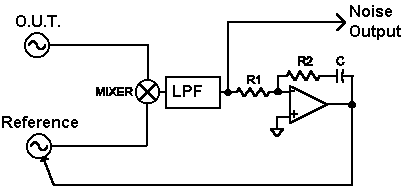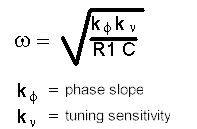Low noise crystal oscillators can exhibit exceptionally low close-in phase noise which cannot be directly measured with a spectrum analyzer or frequency discriminator. The most common measurement technique compares the phase of an oscillator under test to a reference oscillator with similar or superior noise performance. An ordinary PLL can make the measurement easier by holding the relative phase of the two oscillators at quadrature which is usually the best point for converting small phase variations into voltage variations. Although the PLL is constantly working to eliminate these phase variations, the time constant can be set long enough to preserve the slowest phase variations of interest. A typical block diagram is shown below where the oscillator under test and a reference oscillator are directly connected to a double-balanced diode mixer. The mixer output is connected through a low pass filter to block the RF frequencies to a phase lock amplifier. The resistors and capacitor are selected to give a loop bandwidth well below the lowest frequency to be measured. The phase slope is volts per radian and the tuning sensitivity is radians per second – volt which is 2 pi Hz per volt.. (See: useful spreadsheets)

 |
|
The low pass filter should remove radio frequencies but it shouldn’t have a roll-off frequency near the loop bandwidth or else the loop may become unstable and it should be wide band enough to let the noise through at the highest frequency of interest. The noise output is typically sent to a low noise amplifier followed by an audio spectrum analyzer, wave analyzer, or filter. A low noise amplifier may not be necessary if the analyzer noise floor is sufficiently low.
The above scheme is simple in appearance but there are a number of choices, complications and pitfalls.
The simplified procedure for measuring the phase noise follows:
Here is an example of a typical measurement and the required calculations:
Suppose a wave analyzer with a 9 Hz bandwidth measures 17 uVrms at 1 kHz and the mixer has a phase slope of 0.8 volts/radian. Also assume that the low noise amplifier has a gain of 60 dB. First, divide 17 uV by 0.8 volts/radian to convert the voltage into radians. Now divide by the square-root of the measurement bandwidth (sqrt(9) = 3) to normalize to 1 Hz bandwidth. Now calculate the log (base 10) and multiply by 20. Subtract the amplifier gain (60dB), subtract 3 dB if you are assuming the oscillators contribute equal noise to the measurement, and subtract 3 dB to correct for the fact that the measurement is actually double-sideband:
L(f) = 20log(17 x 10-6/(0.8 x 3))-60-3-3 = -169 dBc.
Measuring the phase slope using the beat note technique:
Disconnect the electrical tuning and the low noise amplifier. Connect an oscilloscope to the LPF output. The scope input and trigger should be DC coupled! Detune one oscillator until one full cycle fills the screen with a fairly slow sweep speed. Increase the sweep speed by an exact factor of 100. The full screen is now 0.02 pi radians. Adjust the trigger (not the vertical position!) to measure the slope of the trace as it crosses zero volts. If the trace is curved then try to estimate the line that best fits the curve at the zero crossing. For example, if the trace (or best straight line) spans 50 mV then the phase slope is .05/.02 pi = 0.8 volt/radian
Audio Amplifier: It is fairly easy to build an excellent low noise audio amplifier with ordinary op-amps. Many amplifiers are available with noise voltage below 5 nV per root-Hz and a few exhibit noise below 1 nV. It is useful to have the choice of AC or DC coupling and perhaps two gain settings. Use low value, low noise resistors for gain setting. The technical library has an unusual amplifier circuit featuring low noise junction FETs. This circuit provides 60 dB of AC-coupled gain with three high-pass settings, a DC-coupled 30 dB setting and a 0 dB gain setting for measuring phase slope. The phase lock amplifier includes a slew switch to speed phase locking. The PLL input and the output are buffered. A new Blue Top audio amplifier module (LNAA) is now available featuring noise below 1 nV/root-Hz and gain from 30 to 60 dB. The bandwidth is over 2 MHz at 30 dB gain. The module has a high current output buffer and an optional 50 ohm input termination. This module is new and a data sheet is in preparation.
PLL: The phase-lock amplifier can be an ordinary op-amp in most applications. The amplifier schematic linked above includes a PLL amp. A complete PLL including the phase detector, filter, lock amplifier and voltage regulator is available in a Blue Top module (LNPLL).
Mixer, Filter: The best choice of mixer for phase noise measurement is the ordinary double-balanced diode mixer. The filter that follows the mixer is not particularly critical since the RF signals to be blocked are usually much higher in frequency than the highest phase noise frequency of interest. Suitable Mixers and filters are available from the Blue Tops line.
A commercial phase noise measurement system is another option. Systems are available ranging in price from a few thousand to nearly one hundred thousand dollars and the vendors range from few-person companies to the largest equipment manufacturers.